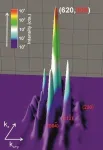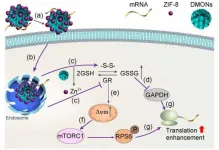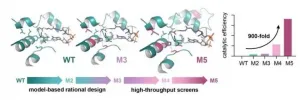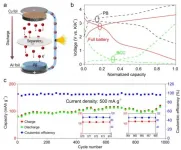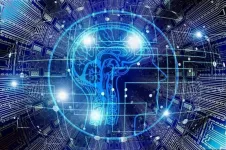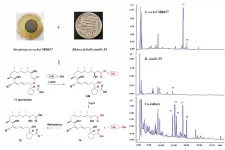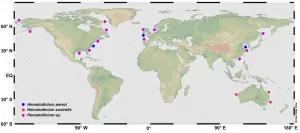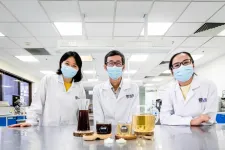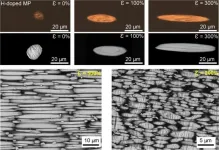Accelerating AI computing to the speed of light
2021-01-11
(Press-News.org) Artificial intelligence and machine learning are already an integral part of our everyday lives online. For example, search engines such as Google use intelligent ranking algorithms and video streaming services such as Netflix use machine learning to personalize movie recommendations.
As the demands for AI online continue to grow, so does the need to speed up AI performance and find ways to reduce its energy consumption.
Now a University of Washington-led team has come up with a system that could help: an optical computing core prototype that uses phase-change material. This system is fast, energy efficient and capable of accelerating the neural networks used in AI and machine learning. The technology is also scalable and directly applicable to cloud computing.
The team published these findings Jan. 4 in Nature Communications.
"The hardware we developed is optimized to run algorithms of an artificial neural network, which is really a backbone algorithm for AI and machine learning," said senior author Mo Li, a UW associate professor of both electrical and computer engineering and physics. "This research advance will make AI centers and cloud computing more energy efficient and run much faster."
The team is among the first in the world to use phase-change material in optical computing to enable image recognition by an artificial neural network. Recognizing an image in a photo is something that is easy for humans to do, but it is computationally demanding for AI. Because image recognition is computation-heavy, it is considered a benchmark test of a neural network's computing speed and precision. The team demonstrated that their optical computing core, running an artificial neural network, could easily pass this test.
"Optical computing first appeared as a concept in the 1980s, but then it faded in the shadow of microelectronics," said lead author Changming Wu, a UW electrical and computer engineering graduate student. "Now, because of the end of Moore's law, advances in integrated photonics and the demands of AI computing, it has been revamped. That's very exciting."
INFORMATION:
[Note: Moore's law is the observation that the number of transistors in a dense, integrated circuit doubles about every two years.]
Other co-authors are Seokhyeong Lee and Ruoming Peng at the UW, and Heshan Yu and Ichiro Takeuchi at the University of Maryland. This research was funded by the Office of Naval Research Multidisciplinary University Research Initiative. Some of this work was conducted at the Washington Nanofabrication Facility/Molecular Analysis Facility at the UW.
For more information, contact Li at moli96@uw.edu.
Grant numbers: N00014-17-1-2661
ELSE PRESS RELEASES FROM THIS DATE:
2021-01-11
Topological materials are characterised by unique electronic and physical properties that are determined by the underlying topology of their electronic systems. Scientists from the Max Planck Institutes for Microstructure Physics (Halle) and for Chemical Physics of Solids (Dresden) have now discovered that (TaSe4)2I is the first material in which a charge density wave induces a phase transition between the semimetal to insulator state.
An international team of scientists at the Max Planck Institute for Microstructure Physics, Halle (Saale), the Max Planck Institute for Chemical Physics of Solids ...
2021-01-11
Delivery of genetic molecules such as mRNA into cells is vital with important applications such as vaccine development. Various agents have been developed for mRNA delivery. However, conventional mRNA nanocarriers mainly focus on their physical interaction with mRNA molecules, or protection / delivery of mRNA, such as adjusting physical properties of nanocarriers to control binding with mRNA or cellular uptake. Moreover, effective mRNA delivery in hard-to-transfect APCs remains a challenge. The hard-to-transfect nature in APCs is partly attributed to the suppressed mRNA translation associated with the intrinsic high intracellular glutathione (GSH) level. Thus, ...
2021-01-11
Photorespiration is a highly energy consuming process in plants that leads to the release of previously fixed CO2. Thus, engineering this metabolic process is a key approach for improvement of crop yield and for meeting the challenge of ever-rising CO2 levels in the atmosphere. Researchers led by Tobias Erb from the Max Planck Institute for Terrestrial Microbiology in Marburg, Germany, have now succeeded in engineering the TaCo pathway, a synthetic photorespiratory bypass. This new-to-nature metabolic connection opens up new possibilities of CO2 fixation ...
2021-01-11
With the rapid development of smart portable electronics and electric vehicles, the consumption of lithium resource will increase dramatically and the cost of lithium-ion batteries (LIBs) may increase significantly in the future. In addition, the shortage (0.0017 wt% in the earth's crust) and uneven crustal distribution of lithium also limit its further development and application. As potassium (2.7 wt% in the earth's crust) have properties similar to lithium and abundant reserves. Therefore, as an alternative to LIBs, potassium ion batteries (PIBs) have become the focus of research. Potassium (2.92 V vs. ...
2021-01-11
Scientists from the Max Planck Institute of Psychiatry, led by Nikolaos Koutsouleris, combined psychiatric assessments with machine-learning models that analyse clinical and biological data. Although psychiatrists make very accurate predictions about positive disease outcomes, they might underestimate the frequency of adverse cases that lead to relapses. The algorithmic pattern recognition helps physicians to better predict the course of disease.
The results of the study show that it is the combination of artificial and human intelligence that optimizes the prediction ...
2021-01-11
The spiky structure that erupts from the smooth surface of a ferrofluid when a magnet is brought close can be predicted more accurately than previously thought. KAUST researchers have shown that computational algorithms can calculate the ferrofluid's bristling response to a magnet by simulating only the liquid's surface layer.
Ferrofluids are liquid suspensions of iron-based particles that behave like a regular fluid, but once a magnet is present, the ferrofluid rapidly shape-shifts to form spikes that align with the magnetic field. Originally developed by NASA, ferrofluids have numerous uses ranging from advanced electronics to nanomedicine and have the potential for even broader use, if their magnetic responses could be predicted more accurately.
Dominik Michels and ...
2021-01-11
Co-culture: stimulate the metabolic potential and explore the molecular diversity of natural products from microorganisms
Announcing a new publication for Marine Life Science & Technology journal. In this review article the authors Xiao-Yue Peng, Jin-Tao Wu, Chang?Lun Shao, Zhi-Yong Li, Min Chen and Chang-Yun Wang from the Ocean University of China, Qingdao, China, Yangzhou University, Yangzhou, China, Qingdao National Laboratory for Marine Science and Technology, Qingdao, China and Shanghai Jiao Tong University, Shanghai, China consider the metabolic potential and molecular diversity of natural products from microorganisms.
Microbial secondary metabolites have long ...
2021-01-11
Announcing a new publication for Marine Life Science & Technology journal. In this review article the authors Caiwen Li, Meng Li and Qian Huang from Institute of Oceanology, Chinese Academy of Sciences, Qingdao, China consider the impact of the parasitic dinoflagellate Hematodinium on aquaculture of marine crustaceans in China.
Hematodinium is a type of parasitic dinoflagellate that infects marine crustaceans globally. The parasite lives mainly in the hemolymph or hemocoels of affected hosts, and results in mortalities due to malfunction or loss of functions of major organs.
In recent years, the parasite has developed into an emerging epidemic pathogen not only affecting wild populations of economically valuable marine crustaceans ...
2021-01-11
Good news for those who need a cuppa to start the day. Researchers from the National University of Singapore (NUS) have created new probiotic coffee and tea drinks that are packed with gut-friendly live probiotics.
Supervised by Associate Professor Liu Shao Quan from the Department of Food Science and Technology at the NUS Faculty of Science, the two doctoral students who worked on these two new beverages assert that their drinks have a great taste, and can be stored chilled or at room temperature for more than 14 weeks without compromising on their probiotic viability.
Traditional probiotic carriers like yoghurts and cultured milks are dairy-based products. The rise in veganism, along with common health issues like lactose intolerance, high ...
2021-01-11
Today's electronic devices strive for new form factors - to make them foldable, stretchable, and deformable. To produce such devices that are highly stretchable or deformable, it is necessary to develop electrodes and circuit lines whose electrical properties can withstand harsh deformation or mechanical damage. To this, POSTECH-Yonsei University joint research team has recently developed liquid metal ink to accelerate printed electronic devices that can be changed into any shape.
Professor Unyong Jeong and Dr. Selvaraj Veerapandian of POSTECH's Department of Materials Science and Engineering, with Professor Aloysius Soon and Dr. Woosun Jang of Yonsei University's Department of Materials Science and Engineering, have developed liquid metal microparticles ...
LAST 30 PRESS RELEASES:
[Press-News.org] Accelerating AI computing to the speed of light
